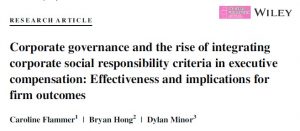A well-thought out and executed research paper provides new evidence that executive pay for performance on ESG issues has a positive impact on company performance Caroline Flammer of Boston University Questrom School designed and led the study with Bryan Hong (NYU Stern) and Dylan Minor (Northwestern Kellogg School). Their analysis showed an improvement in business performance as well as environmental and social performance – along with a decrease in short-termism – associated with tying elements of executive compansation to performance against social and environmental criteria.

The study examined CSR contracting, as this practice is known, among S&P 500 firms over the period from 2004 to 2013. The researchers constructed a longitudinal database with over 4,000 data points of data gathered from the compensation reports in proxy statements filed with the SEC. This robust data set adds weight to the study’s findings. Over the study period, the percentage of S&P firms engaging in CSR Contracting increased from 12.1% to 36.7%.
For firms that adopted CSR contracting, the analysis found the following statistically significant results:
- Firm value increased 3.1% as measured by Tobin’s Q. This, as the authors point out, is a sizable increase on a level commensurate with the adoption of other governance measures.
- A further analysis looking at return on assets (ROA) shows a statistically-significant increase in ROA three years after the adoption of CSR contracting. This suggests that the CSR contracting is indeed delivering higher profits as management decisions are operationalized – not just influencing investors’ perceptions of companies.
- Increased attention to stakeholder impacts with a 5.2% increase in the company’s KLD index. The KLD index is one of the longest-running measures of how well companies address the needs of stakeholders – employees, customers, the natural environment, and communities.
- Improved environmental performance – an 8.7% decrease in toxic emissions. The emissions data is from an authoritative source – the EPA’s Toxics Release Inventory (TRI), for which companies are mandated to report firm-level emissions of 650 toxic substances.
- Increased “green” innovation – a 2.8% increase in the ratio of green patents (pollution, recycling, renewable energy) to total patents. This is necessarily a smaller sample, and from a less direct measure than Tobin’s Q or toxic emissions. Still, a statistically significant change in corporate patent activity is suggestive of both management intent and impact.
- Evidence of longer-term orientation – based on textual analysis of management information provided by corporations in their annual reports. The authors constructed an index (the LT-index) measuring the relative use of long-term vs. short-term wording in annual reports. The choice of a ratio is inspired. It negates the wide variation in styles of corporate reporting among companies by selecting for the changes over time in the reports of the same companies. The index increased 1.2% for firms adopting CSR contracting.
Investment practitioners interested in sustainable investing need more research of this caliber, creativity and breadth. The classic methodology of finance research that reaches the investment management profession has been event studies and the like, examining very short-term fluctuations of stock price after a news event. The combination of a longitudinal study covering 10 years of the entire S&P 500 and the examination of multiple, very different measures of impact is terrific. It does more than provide additional evidence for the value of sustainable investing. Research using – and expanding – these approaches will provide much more actionable information for sustainable investors because it connects action on ESG issues to longer term financial and societal results.
This research will be published in an upcoming edition of the Strategic Management Journal. The article is titled “Corporate governance and the rise of integrating corporate social responsibility criteria in executive compensation: Effectiveness and implications for firm outcomes”.
